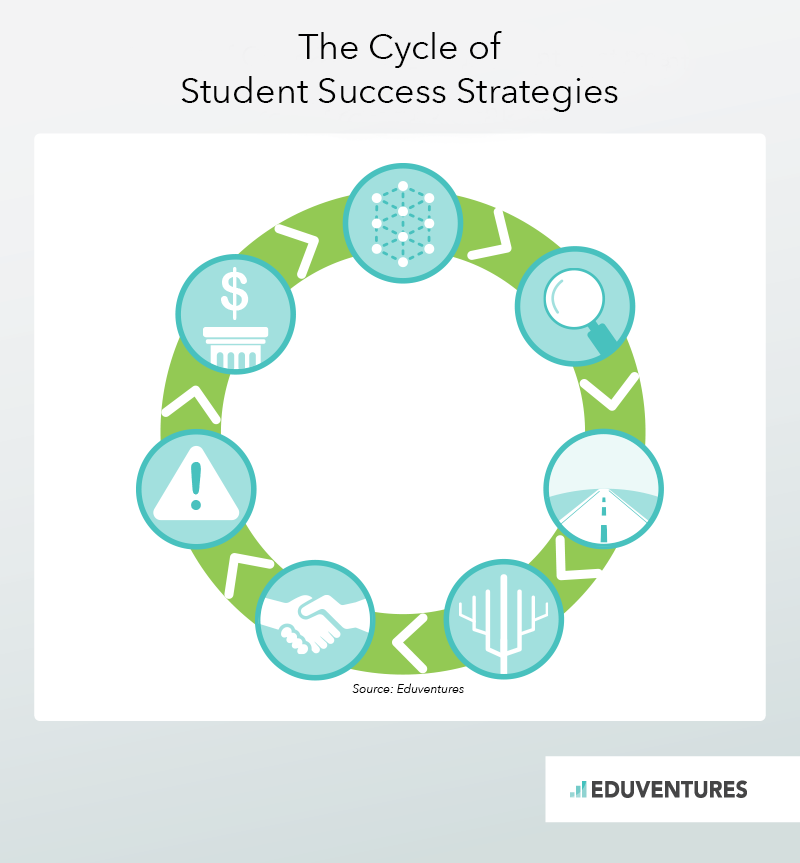Let’s make what could be a generous assumption about your college or university: you’ve done all the hard work. You’ve created a leadership structure and an institutional culture that is ready to collaboratively tackle student success. Your institution knows itself and is ready to act. Now what?
Institutions quickly discover that there is no shortage of opportunities to improve student success. But pursuing a fragmented, uneven, or haphazard effort—a problem we see all too often—can subdue institutional will very quickly. Despite their best intentions, many schools enact a broad array of programs and interventions but never achieve the progress they hoped for. They discover, the hard way, that there is a critical difference between doing a lot of things and doing the right things.
To capitalize on institutional will and momentum, it is imperative to choose a coherent student success strategy that utilizes the main levers that your institution can push to effect change. If you prioritize the strategies that are most important for you, and create programs and interventions that serve these strategies well, you’ll soon find yourself on the path to improvement.
Along with collaborative control over the process, this is absolutely the key ingredient to sustained improvement in student success. Your students will benefit, but you’ll also create a cycle of positive feedback that continuously grows your institution’s commitment to this critical effort.
 We’ve organized the myriad possibilities for programs and interventions that improve student success into seven overarching strategies. They are based on surveys and interviews with top performers identified in Eduventures 2016 Student Success Ratings. These strategies are listed here in order of importance. Top-performers–like University of South Florida, Duquesne University, Texas A&M–Commerce, and Georgetown, have found a configuration of these strategies that was right for their specific student success problem areas.
We’ve organized the myriad possibilities for programs and interventions that improve student success into seven overarching strategies. They are based on surveys and interviews with top performers identified in Eduventures 2016 Student Success Ratings. These strategies are listed here in order of importance. Top-performers–like University of South Florida, Duquesne University, Texas A&M–Commerce, and Georgetown, have found a configuration of these strategies that was right for their specific student success problem areas.







 We’ve organized the myriad possibilities for programs and interventions that improve student success into seven overarching strategies. They are based on surveys and interviews with top performers identified in Eduventures 2016 Student Success Ratings. These strategies are listed here in order of importance. Top-performers–like University of South Florida, Duquesne University, Texas A&M–Commerce, and Georgetown, have found a configuration of these strategies that was right for their specific student success problem areas.
We’ve organized the myriad possibilities for programs and interventions that improve student success into seven overarching strategies. They are based on surveys and interviews with top performers identified in Eduventures 2016 Student Success Ratings. These strategies are listed here in order of importance. Top-performers–like University of South Florida, Duquesne University, Texas A&M–Commerce, and Georgetown, have found a configuration of these strategies that was right for their specific student success problem areas.

1. Provide needed financial support to students
Sometimes the only way forward for a particular set of students is to fill the gap of unmet financial need. Smart institutions study the population that could benefit most from additional funding and work to find the funding for those students. In this case, it is about funding the student directly, not a program. Unfortunately, while most top performing institutions want to pursue this path, funds are not always easy to build into budgets.
2. Focus on academic success
Building a sense of academic self-efficacy is critically important. Top-performing institutions engage in specific academic initiatives that matter most to their campus. They run the gamut from providing better remediation to creating and marketing better academic support services to improved curriculum and course design. Top-performers are committed to creating an environment for academic success for everystudent they admit.
3. Build community connections
The more seamlessly students find their place in your campus community the greater their chances of success are. Top-performers focus on the first-year experience including rethinking activities like freshmen seminars, learning communities, and orientation. Top performers are also making attempts to build campus spirit and provide more welcoming communities for students of all kinds.
4. Actively manage individual student pathways
Top performers take a page out of the consumer research playbook and consider the individual “learning journeys” of their students. They help students find their personal pathways through college. This usually means the reformulation of the advising, coaching, and mentorship ecosystem of their institution.
5. Identify risk and do something about it
A hard look at institutional data helps top-performers understand which students are at risk. The trick they have mastered is to engage members of the campus community to act on that risk. Institutions that have been successful in this area have built predictive models to identify students at risk, used technology tools designed to flag and work with at-risk students, and trained and engaged faculty and advisers into being active participants in ameliorating risk.
6. Clear the path of roadblocks
Institutions often shoot themselves in the foot with unseen or unresolved barriers to student transitions and pathways. The culprit might be poor customer service, cumbersome institutional academic policies, lack of availability of critical courses, or gateway courses that stop student progress. Top performers simplify transition steps for students. For example, one top performer conducted an extensive cross-departmental business process analysis of transition steps for students through the institution. Many other institutions reported clearing barriers by examining and supporting gateway courses and adding sections of critical courses.

